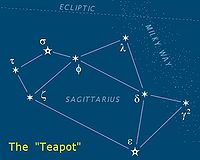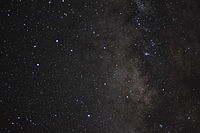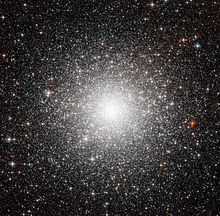- Sagittarius (constellation)
-
"sgr" redirects here. For other uses, see SGR (disambiguation).
Sagittarius Constellation 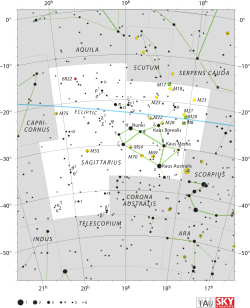
List of stars in SagittariusAbbreviation Sgr Genitive Sagittarii Pronunciation /ˌsædʒɨˈtɛəriəs/, genitive /ˌsædʒɨˈtɛəri.aɪ/ Symbolism the Archer Right ascension 19 h Declination −25° Quadrant SQ4 Area 867 sq. deg. (15th) Main stars 12, 8 Bayer/Flamsteed
stars68 Stars with planets 22 Stars brighter than 3.00m 7 Stars within 10.00 pc (32.62 ly) 2 Brightest star ε Sgr (Kaus Australis) (1.79m) Nearest star Ross 154
(9.69 ly, 2.97 pc)Messier objects 15 Bordering
constellationsAquila
Scutum
Serpens Cauda
Ophiuchus
Scorpius
Corona Australis
Telescopium
Indus (corner)
Microscopium
CapricornusVisible at latitudes between +55° and −90°.
Best visible at 21:00 (9 p.m.) during the month of August.Sagittarius is a constellation of the zodiac, the one containing the galactic center. Its name is Latin for the archer, and its symbol is
 (Unicode U+2650 ♐), a stylized arrow. Sagittarius is commonly represented as a centaur drawing a bow. It lies between Ophiuchus to the west and Capricornus to the east.
(Unicode U+2650 ♐), a stylized arrow. Sagittarius is commonly represented as a centaur drawing a bow. It lies between Ophiuchus to the west and Capricornus to the east.Contents
Visualizations
The constellation's brighter stars (from left to right on the map: τ, ζ, σ, φ, λ, ε, δ, and γ2 Sagittarii) form an easily recognizable asterism known as 'the Teapot'. The stars δ Sgr (Kaus Media), ε Sgr (Kaus Australis), ζ Sgr (Ascella), and φ Sgr form the body of the pot; λ Sgr (Kaus Borealis) is the point of the lid; γ2 Sgr (Alnasl) is the tip of the spout; and σ Sgr (Nunki) and τ Sgr the handle.[1][2]
The constellation as a whole is often depicted as having the rough appearance of a stick-figure archer drawing its bow, with the fainter stars providing its horse body.
Notable features
Stars
α Sgr (Rukbat) is not the brightest star of the constellation, having a magnitude of only 3.96 (not shown on the main map as it is located below the map's southeastern corner, north is up).
With 22 stars in this constellation known to have planets, Sagittarius has more known planetary host stars than any other constellation.
Deep-sky objects
The Milky Way is at its densest near Sagittarius, as this is where the galactic center lies. Consequently, Sagittarius contains many star clusters and nebulae. One of the brightest of the star clusters is Messier 55, about 7.5° west of δ Sgr.
The constellation contains nebulae such as the Lagoon Nebula (Messier 8), near λ Sagittarii, the Omega Nebula (Messier 17), also known as the Swan or Horseshoe Nebula, near the border with Scutum; and the Trifid Nebula (Messier 20), a large nebula containing some very young, hot stars. The grouping of Lagoon Nebula, Trifid Nebula, and NGC 6559 is often called the Sagittarius triplet.
In 1999 a violent outburst at V4641 Sgr was thought to have revealed the location of the closest known black hole to Earth,[4] but later investigation increased its estimated distance by a factor of 15.[5] The complex radio source Sagittarius A is also here. Astronomers believe that one of its components, known as Sagittarius A*, is associated with a supermassive black hole at the center of the galaxy. The Sagittarius Dwarf Elliptical Galaxy is located just outside the Milky Way.
Mythology
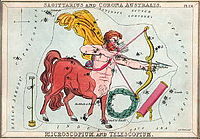 Sagittarius as depicted in Urania's Mirror, a set of constellation cards published in London c.1825.
Sagittarius as depicted in Urania's Mirror, a set of constellation cards published in London c.1825.
The Babylonians identified Sagittarius as the god Nerigal or Nergal, a strange centaur-like creature firing an arrow from a bow.[6] It is generally depicted with wings, with two heads, one panther head and one human head, as well as a scorpion's stinger raised above its more conventional horse's tail. The Sumerian name Pabilsag is composed of two elements - Pabil, meaning 'elder paternal kinsman' and Sag, meaning 'chief, head'. The name may thus be translated as the 'Forefather' or 'Chief Ancestor'.[7] The figure is reminiscent of modern depictions of Sagittarius.
In Greek mythology, Sagittarius is identified as a centaur: half human, half horse. In some legends, the Centaur Chiron was the son of Philyra and Saturn, who was said to have changed himself into a horse to escape his jealous wife, Rhea. Chiron was eventually immortalised in the constellation of Centaurus or in some version, Sagittarius.[citation needed]
The arrow of this constellation points towards the star Antares, the "heart of the scorpion."
Astrology
Main article: Sagittarius (astrology)As of 2002[update], the Sun appears in the constellation Sagittarius from December 18 to January 18. In tropical astrology, the Sun is considered to be in the sign Sagittarius from November 22 to December 21, and in sidereal astrology, from December 16 to January 14.
Notes
- ^ "Sagittarius". deepsky.astroinfo.org. http://deepsky.astroinfo.org/Sgr/. Retrieved 2008-08-30.
- ^ http://www.flandrau.org/astronomy/skywatchers/picupclose.php?picid=89
- ^ "First Globular Cluster Outside the Milky Way". ESA/Hubble Photo of the Week. http://spacetelescope.org/images/potw1145a/. Retrieved 9 November 2011.
- ^ "Dramatic Outburst Reveals Nearest Black Hole". National Radio Astronomy Observatory. http://www.nrao.edu/pr/2000/v4641/. Retrieved 2008-08-30.
- ^ A Black Hole in the Superluminal Source SAX J1819.3-2525 (V4641 SGR), 2001: "Finally, we find a distance in the range 7.40 ≤ d ≤ 12.31 kpc (90% confidence), which is at least a factor of ≈ 15 larger than the initially assumed distance of ≈ 500 pc."
- ^ Page 15 of Origins of the ancient constellations: I. The Mesopotamian traditions, by J. H. Rogers
- ^ Babylonian Star-lore by Gavin White, Solaria Pubs, 2008, page 155
References
- Ian Ridpath and Wil Tirion (2007). Stars and Planets Guide, Collins, London. ISBN 978-0007251209. Princeton University Press, Princeton. ISBN 978-0691135564.
External links
- The Deep Photographic Guide to the Constellations: Sagittarius
- Star Tales – Sagittarius
- Find Sagittarius in the Night Sky
α (Rukbat) • β¹ (Arkab Prior) • β² (Arkab Posterior) • γ¹ • γ² (Alnasl) • δ (Kaus Media) • ε (Kaus Australis) • ζ (Ascella) • η • θ¹ • θ² • ι • κ¹ • κ² • λ (Kaus Borealis) • μ (Polis) • ν¹ (Ain al Rami) • ν² • ξ¹ • ξ² • ο • π (Albaldah) • ρ¹ • ρ² • σ (Nunki) • τ • υ • φ (Nanto) • χ¹ • χ² • χ³ • ψ • ω • b¹ • c • d • e¹ • e² • f • g • h¹ • h² • AFlamsteed 3 • 4 • 6 • 7 • 9 • 10 (γ², Alnasl) • 11 • 13 (μ, Polis) • 14 • 15 • 16 • 17 • 18 • 19 (δ, Kaus Media) • 20 (ε, Kaus Australis) • 21 • 22 (λ, Kaus Borealis) • 24 • 25 • 26 • 27 (φ, Nanto) • 28 • 29 • 30 • 32 (ν¹, Ain al Rami) • 33 • 34 (σ, Nunki) • 35 (ν²) •36 (ξ¹) • 37 (ξ²) • 38 (ζ, Ascella) • 39 (ο) • 40 (τ) • 41 (π, Albaldah) • 42 (ψ) • 43 (d) • 44 (ρ¹) • 45 (ρ²) • 46 (υ) • 47 (χ¹) • 48 (χ²) • 49 (χ³) • 50 • 51 (h¹) • 52 (h²) • 53 • 54 (e¹) • 55 (e²) • 56 (f) • 57 • 58 (ω) • 59 (b¹) • 60 (A) • 61 (g) • 62 (c) • 63 • 65 • 63 OphNearby Ross 154 • Gliese 783 • Gliese 745Other Andromeda · Antlia · Apus · Aquarius · Aquila · Ara · Aries · Auriga · Boötes · Caelum · Camelopardalis · Cancer · Canes Venatici · Canis Major · Canis Minor · Capricornus · Carina · Cassiopeia · Centaurus · Cepheus · Cetus · Chamaeleon · Circinus · Columba · Coma Berenices · Corona Australis · Corona Borealis · Corvus · Crater · Crux · Cygnus · Delphinus · Dorado · Draco · Equuleus · Eridanus · Fornax · Gemini · Grus · Hercules · Horologium · Hydra · Hydrus · Indus · Lacerta · Leo · Leo Minor · Lepus · Libra · Lupus · Lynx · Lyra · Mensa · Microscopium · Monoceros · Musca · Norma · Octans · Ophiuchus · Orion · Pavo · Pegasus · Perseus · Phoenix · Pictor · Pisces · Piscis Austrinus · Puppis · Pyxis · Reticulum · Sagitta · Sagittarius · Scorpius · Sculptor · Scutum · Serpens · Sextans · Taurus · Telescopium · Triangulum · Triangulum Australe · Tucana · Ursa Major · Ursa Minor · Vela · Virgo · Volans · VulpeculaThe Zodiac Astrology | Signs of the Zodiac Aries Taurus Gemini Cancer Leo Virgo Libra Scorpio Sagittarius Capricorn Aquarius Pisces 











Astronomy | Constellations of the Ecliptic Aries Taurus Gemini Cancer Leo Virgo Libra Scorpius Ophiuchus Sagittarius Capricornus Aquarius Pisces Categories:- Astrology
- Sagittarius constellation
- Constellations
- Western astrology
- Southern constellations
- Constellations listed by Ptolemy
- Western constellations
Wikimedia Foundation. 2010.


